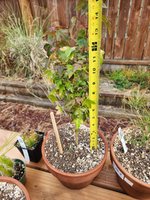Apart from that, I've seen videos recommending to let the tree grow basically unrestrained, but then cut it all back in summer and let it re-grow, is that right? Should I be taking all the branches back to the trunk and letting new shoots bud and grow out? I've also seen some information recommending to chop the trunk as well, but I feel like that would be more appropriate for building taper rather than specifically getting a thicc trunk, do I have that correct?
There is a big difference between the fastest fat trunk and a fat trunk that's good for bonsai.
You can plant in the ground and let it grow for a few years then chop but that will usually give you great fat stump. After that you'll spend quite a few years growing a new apex thick enough to match the fat trunk and then further chops and regrow to build some taper in the trunk. I found that the initial thickness came quick but the following stages took much longer giving an overall longer timeframe to get the size I want.
I find it much better to develop trunk thickness and taper at the same time. It may take a couple more years to reach desired trunk thickness but you'll already have the taper and will usually be way ahead overall.
My regime is:
Grow unrestrained for a year in ground (maybe 2 years in a grow pot?). In winter/spring, root prune hard and chop the trunk hard - approximately where you'd plan for the first branch. Replant in the grow bed/pot.
Let it grow unrestrained for another year/2 then repeat above. You should end up with a trunk with 3 or 4 strong leaders as the result of the initial chop. In winter/spring root prune hard again and chop the top back. This time select 1 of the leaders for the trunk line. I try to pick one that gives a nice bend in the trunk. Remove the others and shorten the keeper - about 2nd branch high?, maybe 1 or 2 nodes.
Repeat until you have the thickness you need, height to match and best trunk bends. Now transfer to a grow pot to slow growth a little and start selecting shoots as branches.
Initially let branches grow unrestrained to gain thickness (may need to trim upper branches to stop them getting too thick at the expense of lower branches. Cut all branches back to the first node. If first node is too far from the trunk chop just away from the trunk and try again. Believe me a branch that starts with a long internode will never look good.
Repeat, building ramification 1 or 2 nodes each year for a couple of years then start pruning more often to build branching with thinner and thinner shoots and shorter sections.
Roots: Contrary to popular belief I find that tridents grow almost as much after root pruning as without. Selectively pruning roots will also develop your nebari much better. Cut off all down roots wherever possible. Shortening lateral roots forces them to branch into more and more roots. As those roots thicken they fuse to give your melted pancake nebari.
Starting with just a couple of thick roots will never reach your goal or will take many more years of root grafting to fill the gaps.
My best trident nebari are formed where seedlings are threaded through holes in sheet metal and buried. As the trunk thickens the plate constricts sap flow and the trunk is forced to put out new roots just above the metal plate. In most cases I get lots of new roots right round the trunk. Those roots can only grow horizontally out and over the plate so we get the flat pancake nebari.

